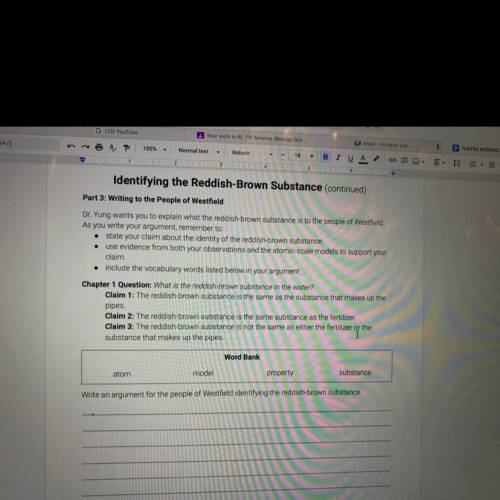
Chemistry, 23.03.2021 16:00 kenziebug34
Identifying the Reddish-Brown Substance (continued)
Part 3: Writing to the People of Westfield
Dr. Yung wants you to explain what the reddish-brown substance is to the people of Westfield.
As you write your argument, remember to:
• state your claim about the identity of the reddish brown substance.
use evidence from both your observations and the atomic-scale models to support your
claim.
• include the vocabulary words listed below in your argument.
Chapter 1 Question: What is the reddish brown substance in the water?
Claim 1: The reddish brown substance is the same as the substance that makes up the
pipes.
Claim 2: The reddish-brown substance is the same substance as the fertilizer.
Claim 3: The reddish brown substance is not the same as either the fertilizer or the
substance that makes up the pipes.


Answers: 1


Other questions on the subject: Chemistry

Chemistry, 21.06.2019 14:30, antoninapride
Which statement justifies that phosphine (ph3) is a polar molecule?
Answers: 1

Chemistry, 21.06.2019 16:20, kingsqueen883
Consider the two electron arrangements for neutral atoms a and b. are atoms a and b the same element? a - 1s2, 2s2, 2p6, 3s1 b - 1s2, 2s2, 2p6, 5s1
Answers: 3


Chemistry, 22.06.2019 00:30, portedon8644
13. calculate the initial concentration (before precipitation) of carbonate ions after the addition of each 0.05 ml of solution b to the 1.00 l beaker of solution a. divide the work among group members and write the answers in the table in model 3. assume the volume change as solution b is added is negligible. 14. notice the initial concentrations of zn2+ - and cu2+ in the table in model 3. a. explain how these were obtained from the data in model 2. b. as solution b is added and precipitates form, do these initial concentrations change? 15. use the data in model 2 to indicate the presence of precipitate (either znco3 or cuco3) after each 0.05 ml addition of solution b in model 3. 16. use the initial concentrations of carbonate ions and zinc ions to calculate the reaction quotient, qsp for the zinc carbonate scenarios in model 3. divide the work among group members and write the answers in the table in model 3. 17. use the initial concentrations of carbonate ion and copper(ii) ions to calculate the qsp for the copper(ii) carbonate scenarios in model 3. divide the work among group members and write the answers in the table in model 3.
Answers: 3
You know the right answer?
Identifying the Reddish-Brown Substance (continued)
Part 3: Writing to the People of Westfield
Questions in other subjects:



History, 10.03.2021 22:00


Spanish, 10.03.2021 22:00

History, 10.03.2021 22:00

Mathematics, 10.03.2021 22:00






